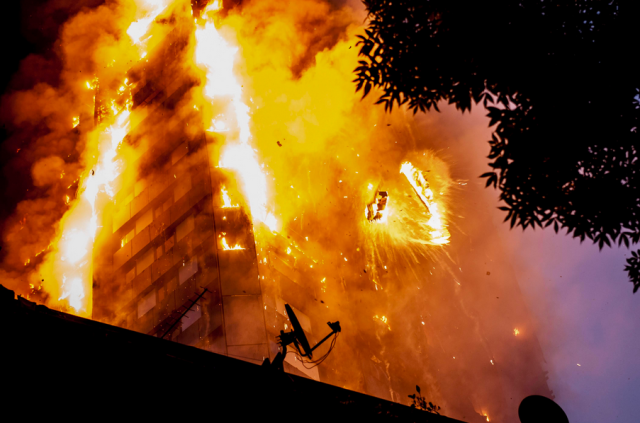
Grenfell Tower aflame in London. (thesun.co.uk)
The Grenfell Tower that burned in London, costing several score of lives, offers lessons that we can and will again fail to heed. No building can be perfectly fireproof, and no ladder truck can reach beyond 20 stories anyhow. If we treated the safety of towers the way we treat, nowadays, the safety of almost everything else, the law would already bar their construction, would have barred it two or three decades ago, especially for the poor. In the case of towers, however, the money interests are even more difficult to defeat than their tenants are difficult to protect. Now the authorities are going after the manufacturers of cladding that stints on safety to achieve low-cost aesthetic relief, on the theory that new crap can improve the appearance of old crap.
As Simon Jenkins points out in his excellent Guardian piece “The lesson from Grenfell is simple: Stop building towers,” London has 400 towers waiting in line for construction when what Londoners – and citizens of cities worldwide – need is neighborhoods. The claim that only skyscrapers can provide the densities cities need to grow is a fraud.
The housing expert Anne Power spoke of the craving of architects and planners at the time for “something distinctive and prestigious.” Architects even invented a vocabulary to justify what was in effect a sales pitch. They would build “vertical streets … villages in the sky … new cities for a new age.” Social consequences were damned. … There is no need to build high at all. The developers’ cry, that cities must build high to “survive,” is self-serving rubbish, the more absurd when their towers are left half-empty. … [T]he most “crowded” parts of London are not around towers but in eight-storey Victorian terraces. The boulevards of central Paris have treble London’s residential density without towers.
Jenkins adds that
[P]eople are entitled to the city they want. When in the 1980s Liverpool’s Militant movement asked Everton’s inhabitants what should be done with their towers, the reply was pull them down and give us back the streets. It was done.
Then, of course, he notes that public housing no longer drives the market for high-rises. No, it is the global rich who want to park their wealth (no doubt honestly accrued!) in a gated apartment they might visit a couple of times a year. I hope that these are built on the sites of old modernist low-rise crap of the sort that London built on Luftwaffe lots for decades before the onrush of towermania. And if – perish the thought – they started building beautiful towers reminiscent of the heyday of Manhattan, then perhaps the case for skyscrapers might carry some weight. But for now, as Jenkins understands, towers are tragedies even if they don’t burn down.



A terrible tragedy, and my condolences to those affected. Very interesting piece. Something to think about.
LikeLike
It’s a tragedy we still build these towers (formerly in a park) 40 years after Alexander stated his Four-Story Limit: http://iwritewordsgood.com/apl/patterns/apl021.htm
Why do not city planners read the world’s most sold book on city planning?
LikeLike
I just can’t understand the process that lead to the installation of these curtain walls that didn’t reach even basic fire safety standards. Is it personal, company, council or government corruption.
LikeLike
The Grenfell was completed in 1974, Lilesosanna, and was dreadfully ugly, typically so for that era. It was 40 years old when the major upgrade to the building was begun, and it was completed last year. Part of the reason for the new cladding was to improve the look of the building, certainly a dubious purpose given that the effort fell so far short of any such goal. I would imagine that all of the forces you cite were partly to blame. The renovation was what I like to call a case of turning an ugly we can blame on our fathers into an ugly we can blame only on ourselves.
LikeLiked by 1 person
Thanks, Steve. That’s about 110 to 160 feet, I think, depending on ceiling height.
LikeLike
Yup…the ladder can reach 110 feet. Normal modern residential floors are
9-10 feet, commercial 11-12 feet.
LikeLike
Good post, Dave – and thanks for that clarification, Steve! I recall reading many years ago about somebody well-known (and name forgotten) who would never book a hotel room beyond the 4th floor for that same reason. My heart aches for all those victims of the Grenfell Tower fire.
LikeLiked by 1 person
I failed to point out, Subscriber, this hopeful thought – traditionally designed high-rises with ornament, cornices, etc., offer more opportunity for crawling outside of windows and holding on (at whatever level). Any port in a storm.
LikeLike
Point of Fact: The highest any fire ladder truck can reach is 11 stories.
LikeLike